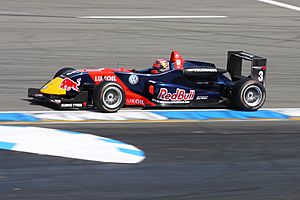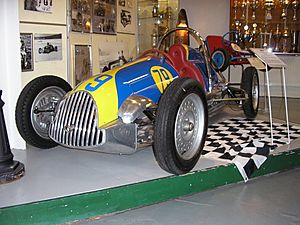Formula Three facts for kids
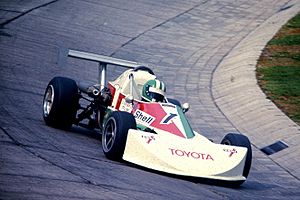
Formula Three, often called Formula 3 or F3, is a type of open-wheel formula racing. It's considered the third level of racing. Many young drivers who dream of reaching Formula One (F1) race in F3 championships in Europe, Australia, South America, and Asia. It's a really important step for them to show their skills!
Contents
History of Formula 3 Racing
Formula Three was officially recognized by the FIA in 1950. It grew out of racing after World War II. Early F3 cars were very light. They had a simple frame and were powered by small 500 cc motorcycle engines. These engines were often from brands like Norton or JAP.
The idea for 500 cc racing started in England in 1946. It was a way for people who loved racing but didn't have a lot of money to compete. These cars were cheap to build and run. Cooper quickly became the top car maker in this type of racing. Their success in F3 helped them grow and build cars for bigger races.
Most 500 cc cars, including Cooper's, had their engine in the middle. This was practical for the chain drive they used. But it also made the cars handle really well! This design choice later led to most single-seater race cars having their engines in the middle.
Many famous drivers started in 500cc Formula Three in the 1950s. These included Stirling Moss, Peter Collins, and Bernie Ecclestone. One of the most successful F3 drivers was Don Parker. He won 126 F3 races! He was even F3 Champion in 1952, 1953, and 1959.
By the late 1950s, the 500cc F3 cars became less popular. A new category called Formula Junior took over. These cars used bigger 1000 or 1100 cc engines.
Engine Changes and Aerodynamics
Formula Three was brought back in 1964 with new rules. Cars now used 1-litre, four-cylinder engines. These engines were highly tuned and revved very high, earning them the nickname "screamers." Races often saw many cars close together, using the "slipstream" effect to go faster. Brabham, Lotus, and Tecno were the top car makers during this time.
In 1971, the rules changed again. Cars could now use 1600 cc engines. These engines had a special air intake. This was also when aerodynamics (how air flows around the car) started to become very important for speed.
Then, in 1974, 2-litre engines were introduced. These also had restricted air intakes. Amazingly, the basic engine rules for F3 have stayed almost the same ever since! This has brought a lot of stability to the sport.
As bigger teams like Lotus and Brabham focused on Formula One, new F3 car builders emerged. These included Alpine, Lola, March, Ralt, and Ensign.
By the 1980s, F3 had become very advanced. It was seen as the main training ground for future F1 drivers. Many drivers went straight from F3 to F1. The cars became more complex, just like F1 cars. For a short time, "ground effects" were used, which helped cars stick to the track. But these were later banned. Carbon fibre parts started to appear in the mid-1980s, making cars stronger and lighter.
Historically, March, Ralt, and Reynard were the main car builders. Reynard was one of the first to use carbon fibre. However, in the 1990s, Dallara became the dominant car maker. Their F393 car was so good that almost everyone started using Dallara chassis. Today, Dallara cars are used everywhere in F3. To keep costs down, Dallara designs their cars to be used for three or four years with only small updates.
Formula 3 Cars
Formula Three cars are special racing machines. They have a single-piece body called a monocoque. They use smooth, slick racing tyres and special wings to help them stick to the track.
Most F3 cars today are made by Dallara. However, other companies like Mygale, Lola, and Arttech also build some. In smaller or amateur F3 races, you might see older F3 cars. These races often have different classes for different car ages.
The engines in the main FIA Formula 3 series are 3.4-litre, 6-cylinder engines. They are naturally aspirated, meaning they don't use turbos or superchargers.
In other F3 series, engines must be based on a regular production car block. Race organizers often seal these engines. This stops teams from making private changes to make them faster. Honda (tuned by Mugen), Volkswagen, and Mercedes engines are very popular.
Car Rules
Here are some of the rules for Formula 3 cars:
- Width: Maximum 1150 mm (about 45 inches)
- Weight: Minimum 550 kg (about 1212 lbs), including the driver
- Steering: Only two-wheel steering is allowed.
- Drive: Only two-wheel drive (rear-wheel-drive)
- Gearbox: Six forward gears (maximum) and one reverse gear. Drivers use paddle-shifts on the steering wheel.
- Brakes: Must be made of iron, not drilled.
- Wheels: Maximum 9.5 inches wide and 13 inches in diameter.
- Fuel: About 45 litres (12 US gallons) of controlled fuel. This fuel is similar to regular pump gasoline (petrol).
- Engine: A 3.4-litre engine from a production car. It has a special 28 mm air restrictor. This limits the power to about 380 horsepower at 8000 rpm.
Championships and Series
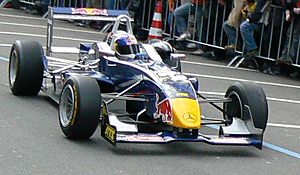
Before 2019, there wasn't one single "World Championship" for Formula Three. In the 1970s and 1980s, the European Formula Three Championship and the British Formula 3 Championship were the most important. Many future Formula One champions came from these series. Countries like France, Germany, and Italy also had their own F3 series.
In 2003, the French and German F3 series combined. They created the Formula 3 Euro Series. This helped make the racing more competitive.
The SudAm Formula Three Championship in Brazil is known for producing great drivers. These drivers often went on to race in the British F3 championship. The All-Japan Formula Three Championship also saw future stars like Ralf Schumacher and Jacques Villeneuve win races. An Asian F3 series started in 2001.
Special Races
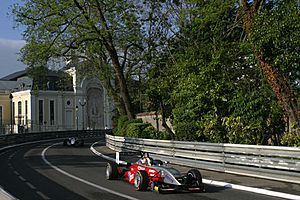
Besides the regular championships, F3 is famous for special races. These races often bring together drivers from different national series. The most well-known is the FIA World Cup at Macau. The first F3 Macau Grand Prix was in 1983 and was won by Ayrton Senna. Other famous winners include Michael Schumacher and David Coulthard. The Macau Grand Prix usually marks the end of the F3 season.
Other important special races include the Pau Grand Prix, the Masters of Formula 3 (held in the Netherlands), and the Korea Super Prix. These events let fans see exciting international racing in different places. The Monaco F3 Grand Prix was also a famous special race until 1997. It was brought back for one year in 2005.
List of Formula Three Series
Current Series
| Series name | Zone/country | Active years | Additional information |
|---|---|---|---|
| FIA Formula 3 regulations | |||
| FIA Formula 3 Championship | International | 2019– | Replaced the GP3 Series and the FIA Formula 3 European Championship in 2019. |
| FIA Formula Regional regulations | |||
| Asia | 2023– | Replaced the Formula Regional Asian Championship in 2023 | |
| North America | 2018– | Was known as F3 Americas until 2019. | |
| Alpine Formula Racing Asia Series | Asia | 2021– | This new championship uses the Tatuus F3R-Spec car with a Renault engine. |
| Europe | 2019– | Replaced the Formula Regional European Championship and the Formula Renault Eurocup in 2021. | |
| Japan | 2020– | ||
| India | 2023– | ||
| New Zealand | 2023– | The series started using the FIA Formula 3 Regional car in 2020. | |
| W Series | International | 2019, 2021–2022 | A Formula 3 championship only for women drivers. |
| Former FIA F3 regulations | |||
| Australia | 2016–2019, 2021– | ||
| Austria | 1982 1984– |
Has a main Cup and a "Trophy" for older cars. | |
| Switzerland | 1978–2008 2014– |
Now runs as part of the Drexler-Autumotive Formula 3 Cup. | |
| Europe | 1994–2005 2016– |
||
| United Kingdom | 2011–2021, 2023– | An amateur racing series using older F3 cars. | |
| Italy | 2014– | Uses mainly older F3 cars and engines. | |
| Euroformula regulations - based on 2018 F3-chassis | |||
| Europe | 2009– | Used to be the Spanish Formula Three Championship. | |
| Japan | 2020– | Was the Japanese Formula 3 Championship until 2019. | |
| GB3 Championship regulations (Upgraded FIA Formula 4) | |||
| United Kingdom | 2016– | This series uses a special Tatuus Formula 4 car with better aerodynamics. | |
| United Kingdom | 1977– | This championship uses F3 cars up to the 2007 Dallara model. | |
| Non-FIA regulations series | |||
| Chile | 1972–1974 1976–2012 2016– | The Chilean championship has its own rules, not the FIA's F3 rules. | |
Defunct Series
| Series name | Zone/country | Active years | Additional information |
|---|---|---|---|
| German Formula Three Championship | Germany | 1950–1953 1971–2014 |
The main championship joined the Formula 3 Euro Series in 2003. |
| British Formula Three Championship | United Kingdom | 1951–1961 1964–2014 |
|
| Soviet Formula 3 Championship | Soviet Union | 1960-1987 | Ended due to financial problems. |
| Italian Formula Three Championship | Italy | 1958–1966 1968–2012 |
|
| FIA European Formula 3 Championship | Europe | 1975–1984 | |
| Formula 3 Euro Series | Europe | 2003–2012 | Became part of the FIA Formula 3 European Championship in 2013. |
| FIA Formula 3 International Trophy | International | 2011 | Replaced by the FIA Formula 3 European Championship in 2012. |
| FIA Formula 3 European Championship | Europe | 2012–2018 | Joined with GP3 Series to create the new FIA Formula 3 Championship in 2019. |
| Japanese Formula 3 Championship | Japan | 1979–2019 | Ended after 41 years when it became Super Formula Lights. |
| Spanish Formula Three Championship | Spain | 2001–2008 | Replaced by the European F3 Open Championship. |
| Formula Three Sudamericana | South America | 1987–2013 | Replaced by Fórmula 3 Brasil. |
| Brazilian Formula Three Championship | Brazil | 1989–1995 2014–2017 |
Ended in 2018. |
| French Formula Three Championship | France | 1964–1973 1978–2002 |
Replaced by the Formula 3 Euro Series. |
| Belgian Formula Three Championship | Belgium | 1964–1967 | |
| Swedish Formula 3 Championship | Sweden | 1964–1994 1997–2000 |
|
| Danish Formula 3 Championship | Denmark | 1949–1966 1976–1977 |
|
| Norwegian Formula 3 Championship | Norway | 1999–2000 | |
| Scandinavian & Nordic Formula Three Championship | Scandinavia | 1984–1985 1992–2001 |
|
| Finnish Formula Three Championship | Finland | 1958–1960 1984–1986 2000–2010 |
|
| North European Zone Formula 3 Cup | Northern Europe | 2008–2009 | |
| Russian Formula Three Championship | Russia | 1997–2002 2008 |
|
| Greece Formula 3 Championship | Greece | 1990–2002 | |
| Turkish Formula Three Championship | Turkey | 1994–2006 | |
| Center-European Zone Formula 3 Cup | Central Europe | 1994–2005 | |
| East German Formula Three Championship | East Germany | 1950–1958 1964–1972 |
|
| Asian Formula Three Championship | Asia | 2001–2008 | |
| United States Formula Three Championship | United States | 2000–2001 | |
| Mexican Formula Three Championship | Mexico | 1990–2002 | |
| Mexican Formula Three International Championship | Mexico | 1990–2003 | |
| BRSCC ARP Formula Three Championship | United Kingdom | 1990–2005 | |
| Formula Lites | United States | 2015 | |
| Formula Renault Eurocup | Europe | 2019–2020 | This series used F3 cars for a short time. It merged with another series in 2021. |
|
|
|||
Special Races
| Event | Track | Region | Country | Championship | Years |
|---|---|---|---|---|---|
| Events | |||||
| FIA Formula 3 World Cup | Guia Circuit | Macau | standalone event | 1983–2019, 2023– | |
| New Zealand Grand Prix | alternating | alternating | Toyota Racing Series | 1950, 1954–1995, 1998–2000, 2002–2021 | |
| Grand Prix de Pau | Circuit de Pau-Ville | Pau | Euroformula Open Championship | 1999–2006, 2011–2012, 2014–2019, 2022– | |
| Masters of Formula 3 | Circuit Park Zandvoort | Zandvoort | standalone event | 1991–2016 | |
| Formula 3 Brazil Open | Autódromo José Carlos Pace | São Paulo | standalone event | 2010–2014 | |
| Eastside 100 | EuroSpeedway Lausitz | Klettwitz | German Formula Three Championship | 2005–2006 | |
| Monaco Formula Three Grand Prix | Circuit de Monaco | Monte Carlo | 1950, 1959–1997, 2005 | ||
| Korea Super Prix | Changwon Street Circuit | Changwon | standalone event | 1999–2004 | |
| FIA European Formula Three Cup | alternating | alternating | standalone event | 1985–1990, 1999–2004 | |
| Fuji Formula Three Cup | Fuji Speedway | Oyama | standalone event | 1990–1993 | |
See also
 In Spanish: Fórmula 3 para niños
In Spanish: Fórmula 3 para niños


